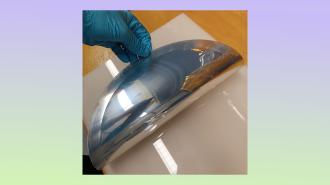A new technique for making space telescope mirrors could create the biggest ever placed in orbit — unveiling our best view yet of deep space.
The challenge: Optical space telescopes, such as Hubble and the James Webb Space Telescope (JWST), use mirrors to gather and focus light coming from distant planets, stars, and galaxies. The bigger the mirror, the more light they can collect, and the more we can see.
Every extra ounce of payload increases the cost of a rocket launch, though, so scientists are limited in the size of mirrors they can send to space.
Even if money wasn’t a factor, rockets have size limitations that prevent us from being able to load them up with really big space telescope mirrors. JWST’s record-breaking mirror is 6.5 meters — over 21 feet — and had to be transported broken down into 18 segments that had to be painstakingly aligned in orbit.
“This new approach … could help solve weight and packaging issues for telescope mirrors.”
Sebastian Rabien
The idea: Researchers at the Max Planck Institute for Extraterrestrial Physics in Germany have now developed a way to produce high-quality space telescope mirrors so thin we could roll them up before placing them in rockets for deployment.
“This new approach — which is very different from typical mirror production and polishing procedures — could help solve weight and packaging issues for telescope mirrors, enabling much larger, and thus more sensitive, telescopes to be placed in orbit,” said researcher Sebastian Rabien.
How it works: The Max Planck team leaned on “chemical vapor deposition” (CVD), a manufacturing technique often used to add coatings to objects, to create an incredibly thin base for their mirror in the parabolic shape needed for space telescopes.
Typically during CVD, the ingredients of a polymer coating are vaporized and added to a vacuum chamber where they assemble on the surface of whatever object is being coated.
Rather than adding a solid object to the chamber, the researchers added a rotating container of liquid. The spinning caused the liquid to pull toward the edges of the container, creating a perfect parabolic shape on the liquid’s surface for the polymer to form on top of.
“Utilizing this basic physics phenomenon, we deposited a polymer onto this perfect optical surface, which formed a parabolic thin membrane that can be used as the primary mirror of a telescope once coated with a reflecting surface such as aluminum,” said Rabien.
“It could make lightweight mirrors that are 15 or 20 meters in diameter a reality.”
Sebastian Rabien
Looking ahead: In addition to creating a 30-centimeter flexible mirror prototype, Rabien’s team also developed and demonstrated a heat-based technique that could be used to correct any imperfections that folding might cause in these space telescope mirrors during transport.
“Although this work only demonstrated the feasibility of the methods, it lays the groundwork for larger packable mirror systems that are less expensive,” said Rabien.
“It could make lightweight mirrors that are 15 or 20 meters in diameter a reality, enabling space-based telescopes that are orders of magnitude more sensitive than ones currently deployed or being planned,” he continued.
We’d love to hear from you! If you have a comment about this article or if you have a tip for a future Freethink story, please email us at tips@freethink.com.
